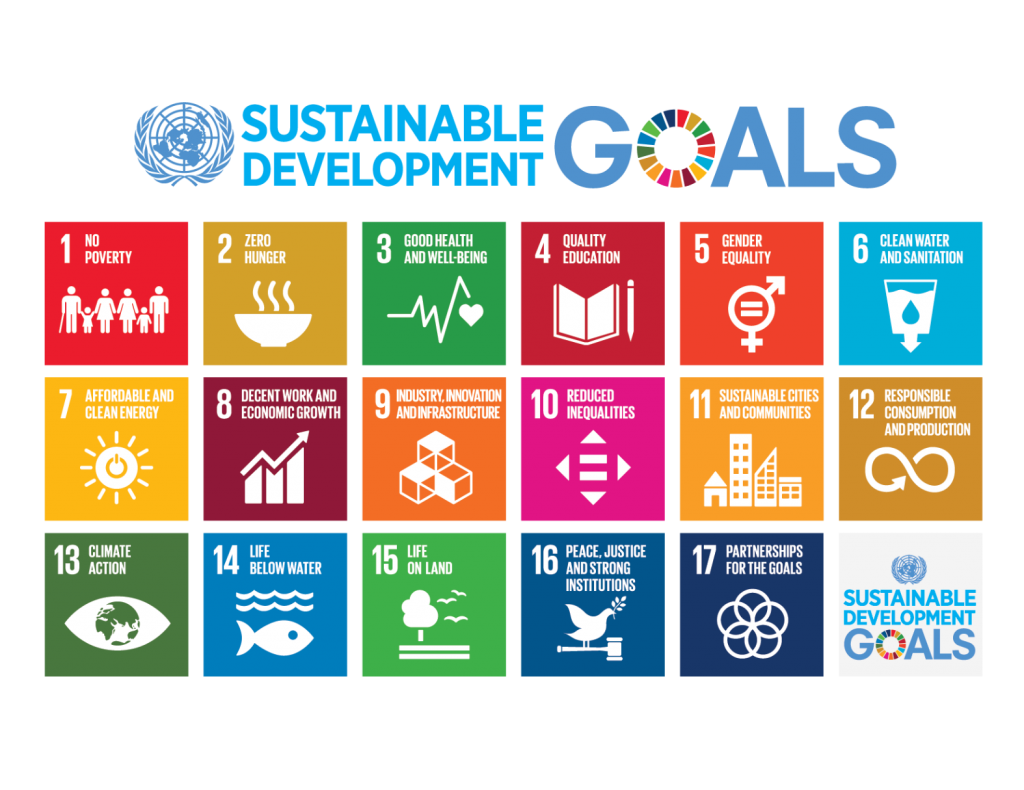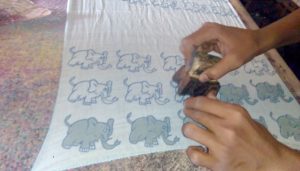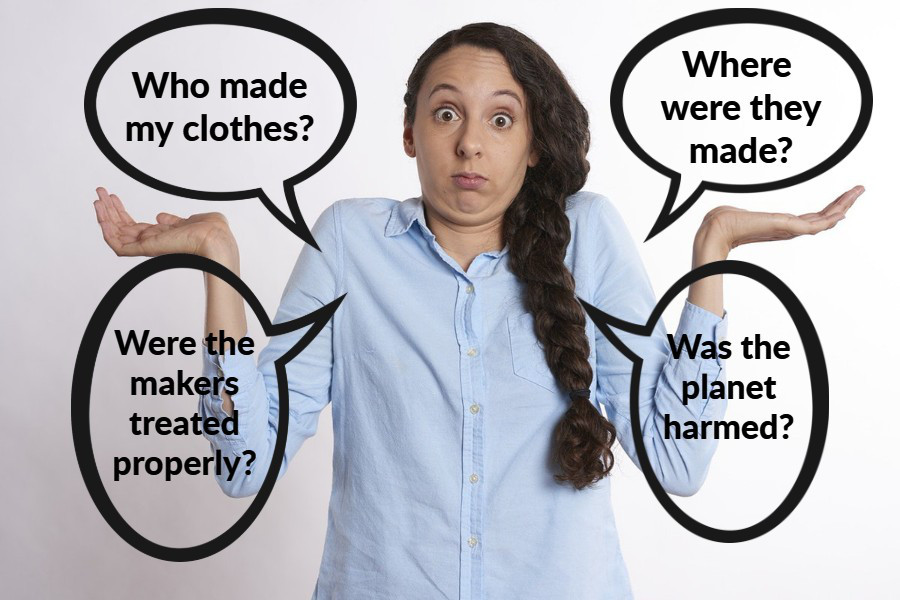Good News: UK consumers shopping more and more thically
2018 was a concerning year in many ways – Brexit, financial pressures due to the economic situation and a worrying tendency for people to embrace intolerance. However it was a positive year for ethical and sustainable consumerism in general and ethical fashion in particular – with mainstream TV documentaries such as Fashion’s Dirty Secrets, campaigns shouting about the impacts of plastic on the environment, The UK Government review into negative impacts of fast fashion and celebrities such as the Duchess of Sussex (Meghan Markle) promoting more ethical designers.

The Ethical Consumer Markets report for 2017 shows a growth of 56.3% in Green Energy and a satisfying 19.9% in Ethical Fashion. A YouGov pole commissioned by Ethical Consumer Magazine found that over a quarter of people had decided not to buy an item in the last year because of its negative environmental or ethical impacts (Up by 65% from 2016).
Where Does It Come From? impact
It’s been an interesting year for Where Does It Come From? Our key highlights are:
– We set up our second transparent supply chain – working with NGOs and social enterprises to create sustainable and ethical clothing in Africa.

– We created new production partnerships for our African supply chain, working with Cotonea to create fabrics from organic, rainfed cotton from Uganda and the Fair trade brand Mayamiko to tailor these fabrics into garments in Malawi. Both these partnerships directly benefit farmers and garment workers in Africa and benefit the environment through ecological farming methods
– We ran 2 more productions with our Indian social enterprise partner Moralfibre fabrics – helping to support their base workforce in local Gujarat co-operatives and artisan groups and protect our planet through use of carbon-free, low water production methods and eco-friendly materials.

- – We continued our partnerships with NGOs Proudly Made in Africa, Action Villages India and Khadi CIC to promote and support their work in developing rural livelihoods.
– We were Finalists in the Suffolk Business Awards (Environment and Sustainability category) and the Blue Patch Awards (Global Impact category).
– Where Does It Come From? collaborated with Ethicalhour to create the first ‘Ethical Brands for Fashion Revolution‘ event in London in April.
– We continued our close collaboration on ‘The Khadi Way’ with Khadi CIC, Fresh Eyes Travel and Moral Fibre Fabrics to promote natural fabrics, running our second event the ‘Festival of Natural Fibres’ in London in September.
- – We provided input into the UK Government review into the impacts of fast fashion
– We had stalls at key events during the year including the Cambridge Sustainable Fashion Festival, Ethical Brands for Fashion Revolution and the British Association for Fair Trade Shops and Suppliers (BAFTS) Annual Conference.

– Our Crowdfund in September and October to fund our African supply chain through pre-orders brought us in £5100 (around 26% of target), new customers and positive publicity.
– Where Does it Come From? was in the news last year with coverage on BBC Look East, interviews on BBC Radio Suffolk, Ipswich Community Radio and Cambridge 105 as well as in newspapers and magazines (see Media coverage on the top menu). We’re also grateful to have been featured in a large number of blogs and podcasts.
– Our wholesale work was less prominent this year, with just one project to create handwoven khadi bags for a wooden toy producer.
- – We partnered with University of Suffolk on research into the business feasibility of our African supply chain project – a project that we hope to continue to further phases.
- – As part of our drive to grow the ethical market place and support ethical entrepreneurs, Where Does It Come From? and Ethicalhour launched the Be the Change Awards – open now for entries.
Mapping impact against the UN Sustainable Development Goals

The UN Sustainable Development Goals (SDGs) were set in 2015 by the UN General Assembly as part of their ‘Transforming our World: the 2030 Agenda for Sustainable Development’. There are 17 goals and the idea is for organisations and individuals to work towards meeting these goals – implementing them in action planning across national legislation, international collaborations, business planning and day to day action.
For Where Does It Come From? The UN Sustainable Development Goals provide a way of expressing and measuring our business ethos – you can find out about the way we work in Our Sustainable Business Processes.
Goal 1: No Poverty – End Poverty in all its forms everywhere
Where Does It Come From? partners with social enterprises in Africa and India who fulfil the 10 principles of Fair Trade. Our collaboration with Moral Fibre Fabrics in India has provided work for hundreds of rural workers, primarily women, working in co-operatives set up for this purpose by Mahatma Gandhi. Our new project in Africa is supporting the training and livelihoods of ecological farmers in Uganda and creating training and employment for women in Malawi.

Goal 2: Zero Hunger – End hunger, achieve food security and improved nutrition and support sustainable agriculture.
We are contributing to this goal indirectly through our work creating livelihoods and employment for hundreds of marginalised people in India, Uganda and Malawi. In the UK we support The Teapot Project through a percentage of sales of our Teapot scarf. This charity takes waste food from supermarkets and redistributes it to those in need.
Goal 3: Good health and well-being for people – Ensure healthy lives and promote well-being for all at all ages
Ensuring the physical and mental well-being of workers is key to our ethos of trade justice. Situations where garment workers are in danger due to overwork, unsafe working conditions or threatening situations are not acceptable.
At Where Does It Come From? we are also focused on our customers’ physical and mental health too. We have always used 100% natural fabrics (cotton or wool) moving towards fully organic product ranges and non-toxic dyes – all of which we believe contributes to our physical well-being.
We believe that sharing the life story of each product with our customers is really important for mental well-being, connecting with the people and processes helping build a better relationship with our things and leader to greater contentment.
We are firm believers in Mindfulness as a way to achieve positive mental health and have created our Mindfulness Serenity Scarf to help people enhance positivity and personal happiness.

Goal 4: Quality Education – Ensure inclusive and equitable quality education and promote lifelong learning opportunities for all.
Whilst Where Does It Come From? does not directly provide education, we do believe that ensuring fairly-paid, secure employment does enhance education opportunities within families, as children are able to go to school rather than contribute to family income.
Our social enterprise partners in India and Africa are involved in educational programmes for their workers, with Cotonea training Ugandan farmers in ecological farming techniques, Mayamiko running a digital academy to share educational content across Africa in local languages.
We also believe strongly in educating and inspiring people more generally about ethical fashion and sustainability, publishing articles (see our blog), speaking at events and getting involved in key campaigns such as Fashion Revolution. The more people understand about the impacts of clothing production on makers and the environment, the more impetus there will be to make positive change.
Goal 5: Gender Equality – Achieve gender equality and empower all women and girls.
Women make up 80% of people who shop for clothing whilst 80% of garment workers are women too. It’s a strange fact that as women our shopping habits directly effect our sisters elsewhere in the world. (Men’s do too of course!)
At Where Does It Come From? equality is a key driver and we ensure that we only work with social enterprise partners who are passionate about providing opportunities for women. Our garment production partners in Africa and India are both run by women and both focus their efforts on creating livelihoods, empowerment and confidence for vulnerable women.
Through our Indian partner, Moral Fibre Fabrics, we work with co-operatives set up by Gandhi to create work opportunities for vulnerable, rural women. This still holds true today, with women being able to earn their own money spinning and weaving cotton near to home or often even at home. Find out more in our blog Women for Women.
Our African partner Mayamiko runs a number of programmes for women offering business skills and loans to those who want to work for themselves. They also use fabric scraps to produce sanitary protection for girls to ensure that they don’t need to miss school when they have their period.
Goal 6: Clean water and sanitation – Ensure availability and sustainable management of water and sanitation for all
Management of water is a key sustainability driver, especially in developing communities and areas where water is scarce. Mass produced cotton can have a hugely detrimental effect to water supplies, not only because it is a ‘thirsty crop’, but also because of the impacts of pesticides from cotton farming and chemicals used in processing the fabric which often end up in local water supplies. According to the World Wildlife Fund it can take up to 2700 litres of water to grow the cotton for one t-shirt, and who can forget Stacey Dooley in ‘Fashion’s Dirty Secrets’ standing in what used to be the Aral Sea – now just a desert since the water was sidelined to provide water for the cotton crops of Uzbekistan?
At Where Does It Come From? we work with our partners to ensure that water usage is kept to the minimum. In India we use hand dyeing processes that use approximately one fifth of the water as used in factory dying, in Africa we have chosen to work with rain fed cotton to help protect local water sources. We work with organic cotton where possible and use natural or azo-free dyes to ensure minimum harmful chemical impact on local water.
Goal 7: Affordable and clean energy – Ensure Access to affordable, reliable, sustainable and modern energy for all.
As of 2017 only 57% of people in the world can rely on clean energy sources whereas the target is 95%. Renewable energy (wind, solar, water powered) and energy conservation are key programmes in clean energy technology.

At Where Does It Come From? we power our office through a clean energy provider in the UK. It is very important to us that our production has a negligible carbon footprint and that energy is sourced and used as cleanly and efficiently as possible. Our khadi production co-operative partners in India are virtually carbon free – using hand spinning and weaving techniques and solar power to run machinery. Fabric is printed using hand printing techniques. Our African partner also has a solar powered workshop. We believe in creating low-carbon clothing and partnering with those that feel the same, which will in turn lead to more understanding and availability of renewable energy sources.
Goal 8: Decent work and economic growth – Promote sustained, inclusive and sustainable economic growth, full and productive employment and decent work for all.
This goal is one of the Where Does It Come From? key foundations – to create and support livelihoods that are worthwhile and fair and contribute towards sustainable economic growth. Mass production of clothing in developing countries (eg. Bangladesh) most often takes place in urban centres with workers having to leave their villages and families and move to cities where their meagre wages means them living in poor accommodation (or on the streets).
Through our work with our NGO and social enterprise partners we support rural livelihoods and work that traditional skills such as hand weaving, spinning, block printing and tailoring. This not only creates satisfaction and provides development and work opportunities, but also keeps these skills alive for the future.
People development is key – training and supporting people to farm ecologically, to create natural fabrics using traditional skills and tailor garments by hand is creating skills and the basis for sustainable economic growth within in the communities where the people actually live.

Goal 9: Industry, Innovation and Infrastructure – Build resilient infrastructure, promote inclusive and sustainable industrialization, and foster innovation.
What we do at Where Does It Come From? is not on an industrial scale but key innovation has been in the setting up of eco-friendly and fair trade supply relationships with clarity right back to the farm.
For larger scale innovation we are working with partners in ‘The Khadi Initiative‘ programme to set up infrastructure, initially in India, to widen the awareness and availability of natural fabric creationWe believe in being part of something bigger, collaboration to make change on a wider scale.
Goal 10: Reducing Inequalities – reduce income inequality within and among countries
We support fair trade and are part of wider initiatives promoting trade justice internationally such as the British Association for Fair Trade Shops and Suppliers (BAFTS).
Goal 11: Sustainable cities and communities – make cities and human settlements inclusive, safe, resilient, and sustainable.
At Where Does It Come From? we believe in sustainable communities and we work with social enterprises such as the khadi co-operatives who support spinning and weaving communities in rural areas close to cotton farms. Our work with The Khadi Initative is already seeing the development of new khadi clusters in India.
Goal 12: Responsible consumption and production – Ensure sustainable consumption and production patterns.
This is the core ethos of Where Does it Come From? Not only do we ensure that all our production is eco-friendly, sustainable and ethical but we also aim to inspire responsible consumption through the sharing of our garment stories. We believe that sharing information about how a garment was produced and introducing customers to the people involved will inspire a deeper connection with their clothing and hopefully lead to them making more considered choices in future about all their products.

As part of our inspiration agenda we publish regular articles on ethical consumerism on our blog (see menu at top of page!) and in other publications, run and take part in events, speak publicly and promote ethical living on social media.
Goal 13: Climate Action – Take urgent action to combat climate change and its impacts by regulating emissions and promoting developments in renewable energy.
Where Does It Come From? and its partners are passionate about combating climate change and the use of energy efficiency processes and renewable energy (See Goal 7).
Goal 14: Life below water – Conserve and sustainably use the oceans, seas and marine resources for sustainable development
Oceans cover 71 percent of our planet’s surface and are essential for our survival – regulating our climate and water systems.
In recent years there has been growing awareness of the impacts on our oceans and sealife through marine pollution including plastics and microplastics finding their way into the seas.
This awareness has led to introduction of legislation in many countries to cut back on single use plastics and ban microplastics in cosmetics. One area often overlooked we feel is the plastic in clothing – (see our blog The Plastic in Clothes – Is It a Plasticky Catastrophe?).
At Where Does It Come From? we don’t use plastic in our fabric or in our packaging and we are working towards becoming a totally plastic free brand. See our Ethical Business Practices for more information.
Goal 15: Life on Land – Protect, restore and promote sustainable use of terrestrial ecosystems, sustainably manage forests, combat desertification, and halt and reverse land degradation and halt biodiversity loss.
Where Does It Come From? is passionate about supporting the natural environment. We work with organic cotton where possible and our recent African production has used ecologically farmed and rainfed cotton too. We use minimal water, carbon and harmful chemicals during production. We also celebrate nature in our designs – featuring bees, ants, flowers and other wildlife. We work hard to ensure our processes and fabrics are vegan.

Goal 16: Peace, Justice and strong institutions – Promote peaceful and inclusive societies for sustainable development, provide access to justice for all and build effective, accountable and inclusive institutions at all levels.
Fast Fashion has been associated with child labour, forced labour and other abuses against garment workers. At Where Does It Come From? we partner with social enterprises that have a clear goal on justice and equality and are working to ensure livelihoods and communities.
As a smaller brand, being part of bigger collaborations and institutions is a key way to be part of change. Our collaboration on The Khadi Initiative, memberships of Social Enterprise UK and the British Association of Fair Trade Shops and Suppliers (BAFTS) and the Organisation for Responsible Businesses (ORB) as well as our participation in mainstream campaigns such as Fashion Revolution, ensure that our actions are part of a bigger drive to ensure justice, inclusion and equality in the garment industry.
Goal 17: Partnerships for the goals – Strengthen the means of implementation and revitalise the global partnership for sustainable development.
This goal is all about collaboration and specifically focuses on public-private partnerships and international co-operation. At Where Does It Come From? we truly believe in collaboration for the greater good – working with brands that would traditionally be seen as competitors to set up events, run campaigns and help grow the awareness and the market for ethically created products.
Let’s Plant Flowers in 2019…..

As we move forward into 2019 Where Does It Come From? will continue to focus on these UN Sustainable Development Goals in our planning and implementation. We believe that the choices that we make in our business and the partnerships we build will ensure that have a positive effect on you, on people who work on our projects and on the wider planet.
Published January 1, 2019 & Filed in Jo’s Soapbox,Where Does It Come From? Blog
